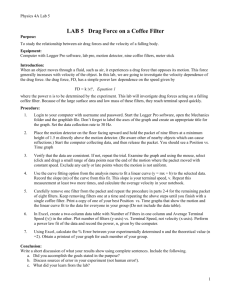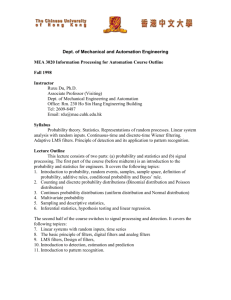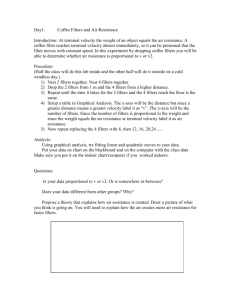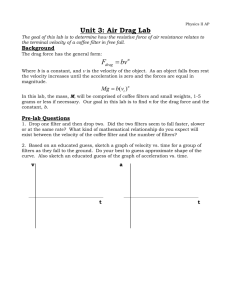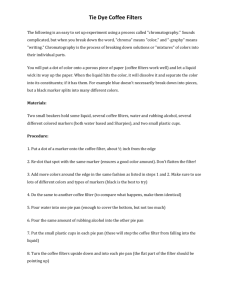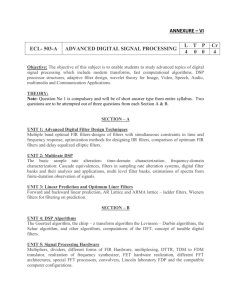Experiment 5. Drag Force and the Drag Coefficient
advertisement
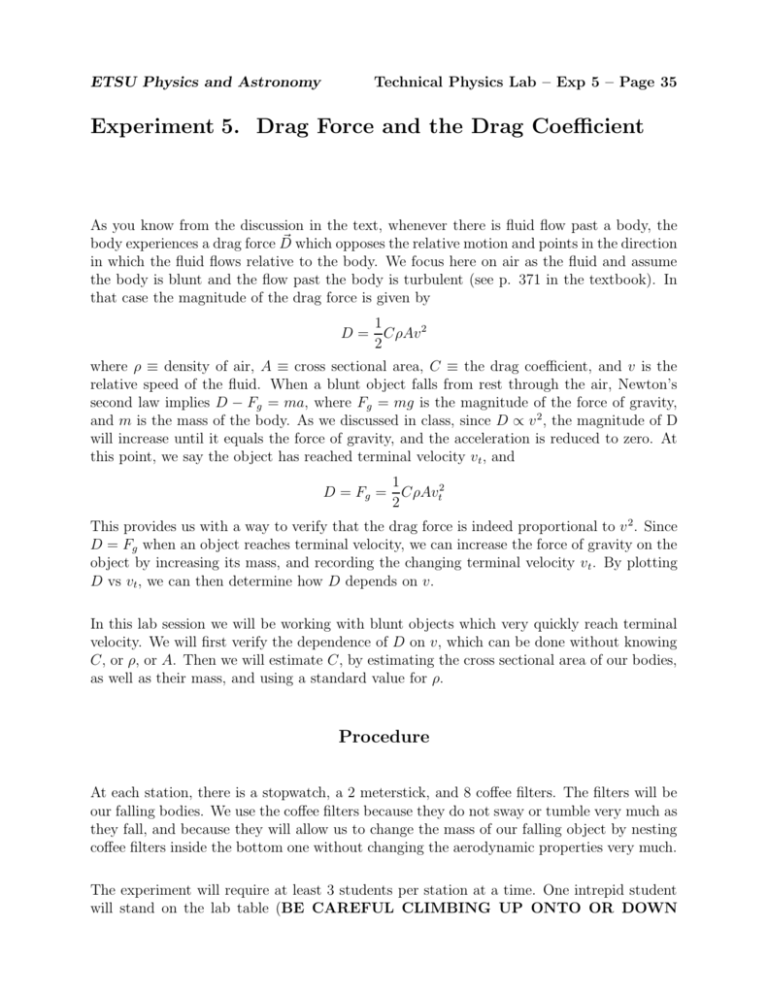
ETSU Physics and Astronomy Technical Physics Lab – Exp 5 – Page 35 Experiment 5. Drag Force and the Drag Coefficient As you know from the discussion in the text, whenever there is fluid flow past a body, the ~ which opposes the relative motion and points in the direction body experiences a drag force D in which the fluid flows relative to the body. We focus here on air as the fluid and assume the body is blunt and the flow past the body is turbulent (see p. 371 in the textbook). In that case the magnitude of the drag force is given by 1 D = CρAv 2 2 where ρ ≡ density of air, A ≡ cross sectional area, C ≡ the drag coefficient, and v is the relative speed of the fluid. When a blunt object falls from rest through the air, Newton’s second law implies D − Fg = ma, where Fg = mg is the magnitude of the force of gravity, and m is the mass of the body. As we discussed in class, since D ∝ v 2 , the magnitude of D will increase until it equals the force of gravity, and the acceleration is reduced to zero. At this point, we say the object has reached terminal velocity vt , and 1 D = Fg = CρAvt2 2 This provides us with a way to verify that the drag force is indeed proportional to v 2 . Since D = Fg when an object reaches terminal velocity, we can increase the force of gravity on the object by increasing its mass, and recording the changing terminal velocity vt . By plotting D vs vt , we can then determine how D depends on v. In this lab session we will be working with blunt objects which very quickly reach terminal velocity. We will first verify the dependence of D on v, which can be done without knowing C, or ρ, or A. Then we will estimate C, by estimating the cross sectional area of our bodies, as well as their mass, and using a standard value for ρ. Procedure At each station, there is a stopwatch, a 2 meterstick, and 8 coffee filters. The filters will be our falling bodies. We use the coffee filters because they do not sway or tumble very much as they fall, and because they will allow us to change the mass of our falling object by nesting coffee filters inside the bottom one without changing the aerodynamic properties very much. The experiment will require at least 3 students per station at a time. One intrepid student will stand on the lab table (BE CAREFUL CLIMBING UP ONTO OR DOWN Technical Physics Lab – Exp 5 – Page 36 ETSU Physics and Astronomy FROM THE TABLE!) They will hold up the coffee filter and release it. Another student will hold the 2 meterstick upright, so that the third student can clearly see both it and the falling filter. The third student has the stop watch, and begins timing when the coffee filter passes the 1.50 m mark of the meterstick (that is, when the coffee filter is 1.50 m above the ground) and stops just as the filter hits the ground. Next, an additional filter should be nested into the first, and the timing repeated. This should continues until all filters are being dropped. This will provide times for 8 different masses. The exercise should then be repeated twice with a new student timing the filters each time. This will provide 3 times for each mass of coffee filter. You then average the times for each mass. Following this, since vt = (1.50/tave ) m/s, one can derive the terminal vt for each mass of filters. Your data table might look something like this: Drag Experiment Data No. of Filters t1 t2 t3 tave vt 1 2 3 4 5 6 7 8 1. The Velocity Dependence of the Drag Force While it is difficult to estimate the mass of a single coffee filter (we will try in part 2!), we can be reasonably confident that 2 coffee filters is twice the mass of 1, 3 coffee filters is 3 times the mass of 1, etc. Since we are simply looking for the velocity dependence in this part, instead of plotting D = mg vs vt , we can plot the number of coffee filters vs vt , since D ∝ number of coffee filters. Make a graph of number of coffee filters (y-axis) vs vt (x-axis). Is there a linear relationship (straight line) relationship between the 2 quantities? ETSU Physics and Astronomy Technical Physics Lab – Exp 5 – Page 37 Now calculate the log of the number of filters, and the log of vt and make a graph of log number of filters vs log vt . As you may know, if independent variable x and dependent variable y are related by y ∝ xn , then n = log y/ log x. Fit a straight line to your graph and calculate the slope (a best fit with a ruler is fine). Is the slope close to 2? If not, are there any sources of error that may be responsible? Note that the slope may not be exactly 2, of course. Is the slope closer to 2 than 1 or 3? 2. Estimating the Drag Force Coefficient C One can try to estimate the drag force coefficient for the coffee filters. Since C= 2mg , ρAvt2 we will need to estimate, m, A, and ρ. The density of air, ρ = 1.20 kg/m3 at the elevation of Johnson City, and we can assume g = 9.80 m/s2 . For m, we can stack 50 filters on the scale, and divide that mass by 50 to obtain the mass of an individual filter. As for the area, trace a circle closely around the filter on a piece of paper and measure the radius. With this information, and your data, make 8 estimates of C. DON’T FORGET TO INCREASE THE MASS IN THE NUMERATOR of the equation for C to account for the increasing number of coffee filters, as well as to include the changing value of vt . What is the average value of C? Calculate the % difference between the largest value and the smallest value. How confident are you in your estimate? Have you any suggestions to improve the procedure? How confident are you in the timings for a large number of coffee filters? Procedure Notes Practice using the stop watch before you begin the experiment. It takes a little time to get used to. As the number of filters gets larger, the times become shorter and shorter. Do your best to get the best time you can. This will be why we will take the average of 3 times. Make sure you know how many filters you are dropping. Try to nest them loose, but securely when you drop them. Don’t flatten the filter when you trace your circle around them. You want to measure the cross sectional area they presented to the air as they fell. Do not forget that once you have made your best fit straight line to a set of data points, that the slope of that line is calculated by considering locations on that line. ETSU Physics and Astronomy Technical Physics Lab – Exp 5 – Page 38 Measuring Apparatus Stop Watch The stopwatches we use measure time to the nearest 0.01 s. Practice with the stop watches for a few times before you start taking measurements in earnest.
